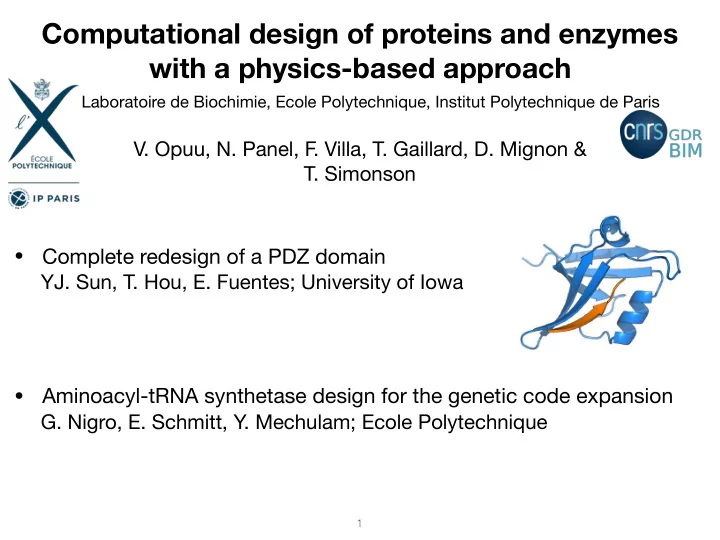

Computational design of proteins and enzymes with a physics-based approach Laboratoire de Biochimie, Ecole Polytechnique, Institut Polytechnique de Paris V. Opuu, N. Panel, F . Villa, T. Gaillard, D. Mignon & T. Simonson • Complete redesign of a PDZ domain YJ. Sun, T. Hou, E. Fuentes; University of Iowa • Aminoacyl-tRNA synthetase design for the genetic code expansion G. Nigro, E. Schmitt, Y. Mechulam; Ecole Polytechnique � 1
Complete redesign of a PDZ domain • Domain length: 83 aas • Establish protein-protein interactions • Mutate positions in a Monte Carlo exploration • Proline, glycine, backbone, and 13 ligand binding positions not allowed to mutate • All 61 others mutate freely: 10 76 possible sequences � 2
Computational framework Experimental backbone structure Monte Carlo moves Change a rotamer or type Rotamer library Physics based energy function E = E MM + E GB + E SA Empirical unfolded state Replica Exchange MC sampling ∑ E uf aa ( type aa ) aa Proteus software (https:proteus.polytechnique.fr) � 3
Designed sequences ressemble natural PDZ sequences 10 4 sequences were obtained Core positions: Proteus vs Pfam Designed Pfam Pfam Frequency Proteus Similarity 37% mean identity � 4
3 sequences chosen for experimental testing All 3 shown to fold correctly 1D-NMR CD spectra FDB 1350 FDB 1555 molar ellipticity FDB 1669 Tiam1 PDZ wavelength 10.0 9.5 9.0 8.5 8.0 7.5 7.0 6.5 6.0 10.0 9.5 9.0 8.5 8.0 7.5 7.0 6.5 6.0 δ 1 H(ppm) δ 1 H(ppm) Fluorometry (B) Normalized RFU Thermal denaturation upshifted by peptide binding Temperature First protein redesign with a physics based energy function Opuu, Sun, Hou, Panel, Fuentes, Simonson, under review, JACS 5 �
Methionyl-tRNA synthetase design for genetic code expansion MetRS tRNA Met + AMP Methionine Azidonorleucine β -Methionine Aminocylated tRNA Met Selenomethionine Homocysteine Phosphinic acid � 6
Design for a ffi nity or catalysis is very di ffi cult • Large combinatorial space • Simultaneous optimization directions: stability, affinity, catalysis • Need to optimize bound/unbound difference: both positive and negative design • Existing methods are heuristic or very expensive: optimize the bound state energy (Rosetta) exhaustive enumeration of states (Osprey) � 7
A rigorous method to sample by a ffi nity: adaptive importance sampling Villa, Panel, Chen, Simonson 2018; Bhattacherjee & Wallin 2013 1) Adaptatively flatten the free energy landscape of the apo state +bias Flattened landscape Natural population Flattened population 2) Simulate holo state with the same bias: bias "subtracts out" the apo free energy Sequences populated according to their binding free energy � 8
As a test: redesign MetRS for Anl binding L260 S13 L301 Anl Anl (Tanrikulu et al, 2009) Azidonorleucine 21 experimental variants (Protein labeling) 3 variable positions 5 of 6 most active variants are among the top 100 predictions � 9
2 nd test: redesign MetRS for Met binding A256 L13 • 21 experimental variants • 3 variable positions MetAMP I297 • 5 active variants among top 40 predictions • Computed a ffi nities in good agreement with experiment: 0.9 kcal/mol mean error, 0.75 correlation � 10
Adaptive importance sampling allows us to design for catalysis 1) Flatten the landscape of the PPi substrate complex Met 2) Sample the transition state complex, including the bias AMP Sequences populated according to their activation free energy � 11
MetRS redesigned for catalytic power kT × ln ( K M ) k cat • 21 experimental values Computational (kcal/mol) 1 ● ● WT ● ● ● 0 ● ● ● ● • 13 among top predictions − 1 ● ● ● ● ● ● − 2 ● ● ● ● ● ● ● ● • ● ● − 3 ● ● Excellent agreement for � k cat / K M ● ● ● ● ● ● ● ● − 4 ● ● ● ● ● ● − 5 ● ● • 0.8 correlation, 1.1 kcal/mol mean error − 7 − 6 − 5 − 4 − 3 − 2 − 1 0 Experimental (kcal/mol) Opuu, Nigro, Villa, Gaillard, Schmitt, Mechulam, Simonson, accepted, Plos Comp. Bio. � 12
Design MetRS for β -Met activity • 3 positions allowed to mutate (more underway) • Good agreement for � k cat / K M • 4 variants discovered with improved selectivity β -Methionine 10 Relative β -Met activity x 10 3 9 8 7 6 x 200 5 4 3 2 1 4.5 10 − 5 0 WT LAC SAC CAC MAC sequence � 13
Summary & Acknowledgements • First whole-protein redesign with a physics-based energy function • First design of an enzyme for catalytic power • good agreement with experiment • predicted variants have improved β -Met selectivity • • PDZ collaborators: MetRS collaborators: Ernesto Fuentes, Giuliano Nigro, Titus Hou Christine Lazennec- Young Joo Sun Schurdevin, Yves Mechulam, Emmanuelle Schmitt • Computing group: Alexandrine Daniel, Thomas Gaillard, Vaitea Opuu, David Mignon, Nicolas Panel, Francesco Villa, Thomas Simonson
Recommend
More recommend